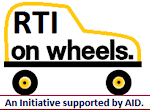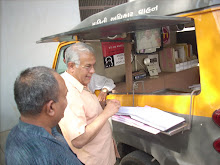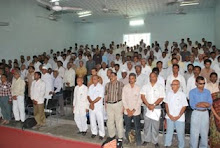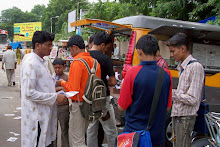Scroll.in:
New Delhi: Sunday, January 20, 2019.
Toxic
levels of air pollution monitored over Delhi almost every week from November 1
last year to January 6 showed that the government’s emergency plans to tackle
the city’s annual crisis have failed, said a report of United Residents Joint
Action or URJA, a collective of the city’s resident welfare associations.
The
report comes at a time when Delhi’s air-quality rose above hazardous levels on
January 17 in some areas, up to three times higher.
The
report summarised the findings of 45 right-to-information applications filed to
14 government departments. Responses were sought from central, state and
municipal bodies to assess the effectiveness of the Graded Response Action Plan
or GRAP, the strategy launched by the government in January 2017.
The
analysis of data collected by URJA for 68 days showed that except one day in
central Delhi’s ITO region, the capital’s air quality was continually above
permissible limits.
To
curb rising air pollution in Delhi and the National Capital Region, the
Ministry of Environment, Forests and Climate Change had notified the
implementation of GRAP through the Environment Pollution (Prevention &
Control) Authority. In November 2016, air pollution in Delhi had reached 16
times above safe levels, and the Delhi government had declared an emergency.
Over
the last two years, Delhi’s pollution levels were high enough to affect the
respiratory and cardiac systems of even healthy people. The health impacts of
this pollution may be experienced even during “light physical activity”, as
IndiaSpend reported on June 15, 2018.
GRAP
entails a number of actions to be taken as soon as the city’s air reports toxic
particulate matter, or PM 2.5, at levels between 61-120 µg/m3 and 300+ µg/m3.
The World Health Organisation standard for permissible level of PM 2.5 in the
air (24-hour average) is 25 μg/m3 while India’s National Ambient Air Quality
standard allows levels 1.4 times higher at 60 μg/m3.
The
GRAP system categorises pollution levels based on national air-quality index
readings generated by the air-quality monitors of the Central Pollution Control
Board. The steps taken under GRAP are graded as per the level of pollution.
These include a ban on garbage burning and entry of trucks into the city, and
the closure of power plants, brick kilns and stone crushers depending on how
bad the air quality is, as IndiaSpend reported on November 9, 2017.
The
problem has worsened in Delhi due to a number of reasons – crop burning in
neighbouring states, construction activity, traffic and emission from power
plants. In winter, the problem becomes even more acute because stagnant winds
do not allow the pollution to disperse.
Air
quality unhealthy through the study period
As
we mentioned earlier, data showed that Delhi’s air quality was unhealthy
throughout the 68-day period of the study except for a small exception. The
nine monitors yielded 612 readings and PM 2.5 levels were observed to be above
300 µg/m3 in 104 cases. When ambient PM 2.5 levels persist at above 300µg/m3
for more than 48 hours, all the emergency steps listed under GRAP are
activated.
“The
information received from the RTI responses shows that despite such detailed
process and notification to act when air quality levels are bad, there is a
lack of proper implementation of measures and awareness levels of departments
responsible for overseeing implementation to curb pollution under GRAP,” said
the URJA press release.
All
the regions covered in the study reported average PM 2.5 levels at least five
times above the permissible limit in this period. Anand Vihar in east Delhi and
Ashok Vihar in west Delhi showed an average of PM 2.5 levels about 1o times
above the permissible limit.
The
Central Pollution Control Board, the Delhi Pollution Control Committee and the
India Meteorological Department – the three agencies responsible for keeping
tabs on the city’s air quality – are supposed to work in tandem to process data
and inform the Environment Pollution (Prevention & Control) Authority about
their findings. The Environment Pollution (Prevention & Control) Authority then
formulates measures to combat pollution and convey them to the respective
authorities. However, the coordination between the agencies was not smooth.
Only
39% attendance at meetings
GRAP
cannot work effectively unless various agencies across the NCR and neighbouring
states work together, IndiaSpend had reported on November 9, 2017. There are 12
agencies responsible for the implementation of GRAP.
It
is evident from the URJA report that the attendance of the responsible agencies
was low at 39%.
Of
the 18 GRAP meetings held, the Public Works Department, Delhi Metro Rail
Corporation and the DISCOMs attended just one. Of the 12 agencies involved,
seven attended less than half these meetings.
“The
Graded Response Action Plan is a well-thought-out policy, the need is to
implement it on the ground and tackle the air pollution levels rising every
year in Delhi,” said Atul Goyal, the president of URJA. “However, the RTI
replies show that most agencies and departments are unaware of their duties and
responsibilities as clearly mentioned under GRAP. But with many important
questions remaining unanswered by the agencies, it is evident that they are
either not aware of the steps under GRAP or not ready to perform their duties.
In both situations, the policy is a failure, leaving the citizens of Delhi
gasping for breath.”














































































